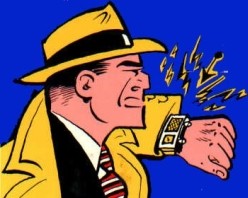Dick Tracy Originally Written/Illustrated by: Chester Gould
Published by: IDW
Edited & Designed: Dean Mullaney
Foreward: Max Allen Collins
Afterword: Jeff Kersten
On October 4th, 1931, in the Detroit Mirror newspaper, Chester Gould’s Dick Tracy made his debut. From that October day in 1931 until 1977, Chester Gould wrote and illustrated Dick Tracy. Published by the Chicago Tribune and the New York News Syndicate (among a slew of others, the formers being the largest outlets), Dick Tracy quickly became a part of our culture.
Dick Tracy used crazy gadgets (it could be argued he had as much to do with police technology as Star Trek did for daily technology), forensic science techniques, and true police procedures to apprehend Mumbles, Flattop, Oodles, and Rughead. Those were only a few of the cast of characters and villains Gould partnered with and pitted Tracy against during his 46 year run with the character.
IDW’s release of the Dick Tracy dailies is as complete of an anthology as you can get. Volume 16…yes, 16, reprints the years 1954-1956 of the dailies and Sundays Dick Tracy was published in. The Complete Dick Tracy collection is one part history book, one part comic, and all parts fantastic.
Being able to go back to read the daily Dick Tracy stories that Chester Gould cranked out was a real joy. Gould’s writing captured the times. He played on our culture’s sensibilities and our identity with his strip. He gave us extraordinary and consistent artwork. He opened the door for the 38 CSI shows on television (ok, I might be stretching there but one read of Tracy teaching Junior about forensics is enough for me to make such a bold statement). His rogue’s gallery for Tracy paved the way for modern superheroes’ villains. The stories are classic despite being well dated by today’s standards.
The Foreward by Max Allen Collins (Road to Perdition), who succeded Gould as writer of Dick Tracy in 1977 (until 1993) gives the reader a history lesson in to Dick Tracy. Nuggets of information about Gould’s failed writings (he was essentially type-cast with Dick Tracy), the cultural impact of the detective, and how he helped in the creation of another detective. The Dark Knight Detective, Batman was a nice opening before diving in to the strips themselves.
The Afterword by Jeff Kersten (founding member/President of the Board at the Chester Gould/Dick Tracy museum) is another history lesson on Tracy’s creator, Chester Gould and a fitting ending to the collection.
The book is long (1954-1956 of daily newspapers makes for a lot of reading) but is well worth its length. It captures what Max Collins believes to be some of Gould’s strongest work since the character’s inception. I found it a fun read and I found it to be an education on a character I admittedly did not know as much about as I thought I did.
*Author’s Note: I became a bit obssessed with Dick Tracy after the 1990 Warren Beatty movie but pre-Internet days made it difficult to gather a whole lot of information on the character. Which means it wasn’t free floating up in a bandwidth cloud.*
His significance is undeniable. Dick Tracy had his image on everything through the years. Wagons, cars, spaceships, he has been an action figure, in comic books, movies, and television. He was on the radio, he was spokesperson for products, and he made me believe the calculator watch I had when I was 10 was really a two way wrist radio. Dick Tracy is a character every fanboy or fangirl should read at least once. So if you get the chance, read this collection. Read some of it, all of it, but just read it. It is a great look back at one our finest characters.
Congratulations Soldier, The Complete Dick Tracy Volume 16 gets 3 out of 4 Salutin’ Caps. Well done.
*cover photo from www.eetimes.com




